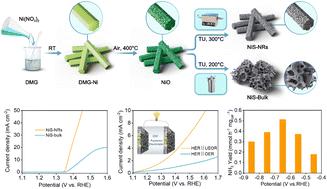当前位置:
X-MOL 学术
›
J. Mater. Chem. A
›
论文详情
Our official English website, www.x-mol.net, welcomes your
feedback! (Note: you will need to create a separate account there.)
Porous nickel sulfide nanorods serve as a multifunctional electrocatalyst for the hydrogen evolution reaction, urea electrooxidation reaction, and nitrate reduction reaction
Journal of Materials Chemistry A ( IF 10.7 ) Pub Date : 2024-08-31 , DOI: 10.1039/d4ta03840a Xiaoyu Zhang 1 , Jiayi Wang 1 , Kai Zong 1 , Lin Yang 1 , Xin Wang 1 , Zhongwei Chen 2
Journal of Materials Chemistry A ( IF 10.7 ) Pub Date : 2024-08-31 , DOI: 10.1039/d4ta03840a Xiaoyu Zhang 1 , Jiayi Wang 1 , Kai Zong 1 , Lin Yang 1 , Xin Wang 1 , Zhongwei Chen 2
Affiliation

|
Rational design and simple synthesis of multifunctional electrocatalysts have significant implications across various scientific and industrial fields. In this work, we successfully synthesized nickel sulfide catalysts featuring a one-dimensional porous nanorod morphology (NiS-NRs) through a hard-template-high-temperature calcination approach. In this method, nickel-dimethylglyoxime complex nanorods ((DMG)2Ni) served as a precursor and inexpensive thiourea as a sulfur source. The urea electrooxidation reaction (UEOR) in water electrolysis presents an opportunity to replace the kinetics-limited oxygen evolution reaction (OER), offering an energy-efficient means of hydrogen production. For the urea electrooxidation reaction, an overvoltage of 1.37 V (versus RHE) was required to achieve a current density of 10 mA cm−2. Similarly, for the hydrogen evolution reaction, a modest overvoltage of 255 mV resulted in a current density of 10 mA cm−2. In a two-electrode system, the NiS-NR‖NiS-NR urea electrolyzer demanded a potential of 1.24 V at 1 mA cm−2, surpassing the aqueous electrolyzer requirement (1.41 V vs. RHE). Meanwhile, the as-prepared NiS-NRs also showed a high nitrate reduction reaction (NO3RR) performance, with a high NH3 yield rate (0.513 mmol h−1 mgcat−1) at −0.65 V vs. RHE. These results verified that the high-temperature calcination process employing a hard template effectively preserved the one-dimensional morphology of the initial template. The resultant nickel sulfide catalysts exhibit commendable electrocatalytic performance for urea electrooxidation, hydrogen evolution and nitrate reduction reactions.
中文翻译:

多孔硫化镍纳米棒作为多功能电催化剂用于析氢反应、尿素电氧化反应和硝酸盐还原反应
多功能电催化剂的合理设计和简单合成对各个科学和工业领域具有重要意义。在这项工作中,我们通过硬模板高温煅烧方法成功合成了具有一维多孔纳米棒形貌(NiS-NRs)的硫化镍催化剂。在该方法中,镍-二甲基乙二肟复合物纳米棒((DMG) 2 Ni)作为前体,廉价的硫脲作为硫源。水电解中的尿素电氧化反应(UEOR)提供了取代动力学限制的析氧反应(OER)的机会,提供了一种高效节能的制氢方法。对于尿素电氧化反应,需要1.37V(相对于RHE)的过电压来实现10mA cm -2的电流密度。类似地,对于析氢反应,255 mV 的适度过电压导致 10 mA cm -2的电流密度。在双电极系统中,NiS-NR‖NiS-NR尿素电解槽在1 mA cm -2下需要1.24 V的电势,超过了水电解槽的要求(1.41 V vs. RHE)。同时,所制备的NiS-NRs还表现出高硝酸盐还原反应(NO 3 RR)性能,在-0.65 V vs. RHE下具有高NH 3产率(0.513 mmol h -1 mg cat -1 )。 这些结果验证了采用硬模板的高温煅烧过程有效地保留了初始模板的一维形貌。所得的硫化镍催化剂在尿素电氧化、析氢和硝酸盐还原反应中表现出值得称赞的电催化性能。
更新日期:2024-09-05
中文翻译:

多孔硫化镍纳米棒作为多功能电催化剂用于析氢反应、尿素电氧化反应和硝酸盐还原反应
多功能电催化剂的合理设计和简单合成对各个科学和工业领域具有重要意义。在这项工作中,我们通过硬模板高温煅烧方法成功合成了具有一维多孔纳米棒形貌(NiS-NRs)的硫化镍催化剂。在该方法中,镍-二甲基乙二肟复合物纳米棒((DMG) 2 Ni)作为前体,廉价的硫脲作为硫源。水电解中的尿素电氧化反应(UEOR)提供了取代动力学限制的析氧反应(OER)的机会,提供了一种高效节能的制氢方法。对于尿素电氧化反应,需要1.37V(相对于RHE)的过电压来实现10mA cm -2的电流密度。类似地,对于析氢反应,255 mV 的适度过电压导致 10 mA cm -2的电流密度。在双电极系统中,NiS-NR‖NiS-NR尿素电解槽在1 mA cm -2下需要1.24 V的电势,超过了水电解槽的要求(1.41 V vs. RHE)。同时,所制备的NiS-NRs还表现出高硝酸盐还原反应(NO 3 RR)性能,在-0.65 V vs. RHE下具有高NH 3产率(0.513 mmol h -1 mg cat -1 )。 这些结果验证了采用硬模板的高温煅烧过程有效地保留了初始模板的一维形貌。所得的硫化镍催化剂在尿素电氧化、析氢和硝酸盐还原反应中表现出值得称赞的电催化性能。































 京公网安备 11010802027423号
京公网安备 11010802027423号